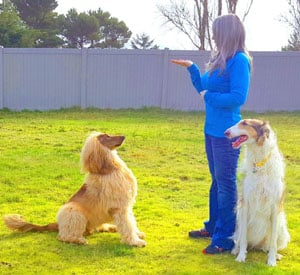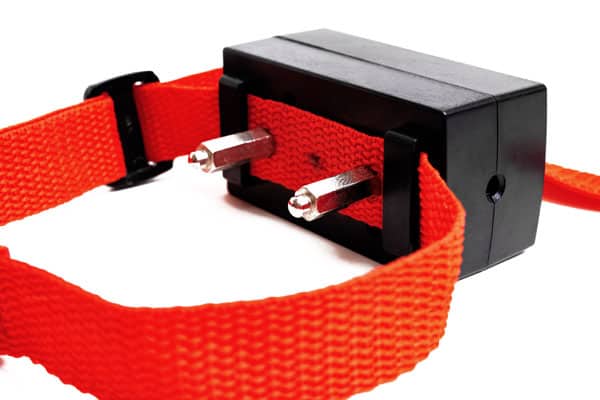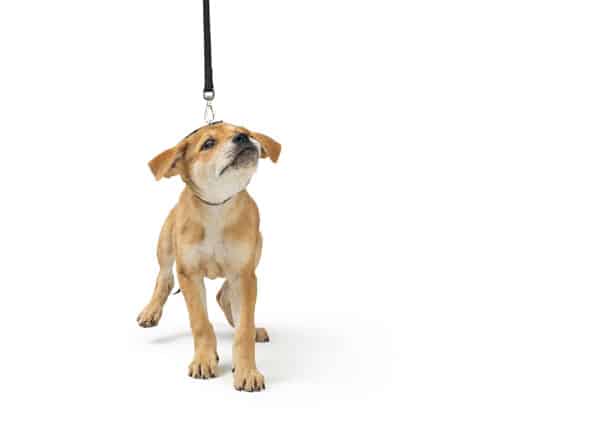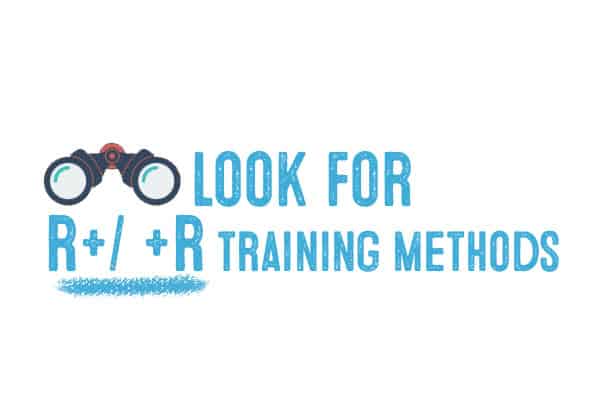On occasion, our posts contain affiliate links. However, we only recommend products that we truly believe in. For more information, visit my privacy policy page.
Rain Jordan, CBCC-KA, CPDT-KA, KPA CTP, Fearful Dogs Expert www.ExpertCanine.com
Anything that an animal seeks to avoid or escape can be considered “aversive” to that animal.
Since our pet dogs—at least in this country—are usually captive animals, we must elaborate on that definition: Anything that the dog would avoid or escape if it were possible to do so can be considered aversive to that dog.
To simplify even more, we might say that anything the dog finds unpleasant is aversive to that dog – that really broadens the view, doesn’t it?
While we should not rely solely on it, one of the rules of identifying aversives is that the individual animal decides what is aversive.
For your dog, it might be strangers, other dogs, medicine, baths, grooming, veterinary offices, etc.
For others’ dogs, sirens might be aversive, or the microwave ding, or kids screaming, or the smell of grandma’s perfume.
When a dog finds common items and experiences aversive, we have a few choices:
1) Management — for example, if the dog finds the microwave ding aversive, management options include you staying near the microwave in order to press “stop” before the ding occurs, or seeking out a less dingy microwave or
2) Desensitization & Counterconditioning (D/CC) –If the aversive is a sound, D/CC alone may not be enough, though.
Sound phobic dogs may require medication as well.
Thunderstorms and fireworks are common aversives and D/CC to these may not be as helpful without the support of medication.
Furthermore, sound phobia can be a threat to health and even life, another reason to consider medication.
There are exceptions to “the dog decides what is aversive “mantra,” however.
Some things, like pain, fear, and force are inherently aversive.
Therefore, things like choke, prong, anti-bark, and shock collars—misleadingly described as “e-collar,” “electronic collar,” “stim,” “tens unit,” “remote communication device,” “vibrating collar,” and various other creative monikers such as “tap” and “tickle,” by those who want you to use them—should always be considered aversive.
Why You Should Avoid Aversives in Your Dog’s Life
First, there’s a welfare concern. Discomfort, pain, fear, force, intimidation, coercion: all decrease the well-being of any animal, including your dog.
Second, aversive experiences tend to create negative associations.
If your dog experiences pain or forceful handling during her vet visit, there is a very strong chance she will associate the vet or the vet office, or both, with discomfort.
That association will remain with her into the future, making every following visit scary for her. Trips to the vet come to predict unpleasantness.
Negative associations tend to lead to negative—that is, undesired by us—behaviors.
If a dog only gets a car ride when it’s vet visit time, and the vet visit experience has become aversive to the dog, there’s a good chance the dog will eventually refuse to get into the car.
If forced into the car, a dog might fight back or even bite in order to escape the vehicle, which she now associates with pain, fear, or other discomfort.
This is also one reason that dogs who don’t usually bite might bite a vet or vet tech.
Sensitization and generalization are further risks of aversive experiences.
Sensitization is what happens when the dog is repeatedly exposed to a given aversive without careful, humane behavioral treatment to counter the negative association until the stimulus is no longer aversive.
The more incidental exposures, the more sensitive the dog will become to that stimulus; over time it takes less and less exposure to result in worsened behavior related to the aversive.
Generalization; At some point, without anti-aversive interventions, the negative association with the stimulus and the behavior related to the association can “generalize.”
This means that the dog may begin to react to other stimuli the same way she reacts to the original aversive.
A dog who was originally afraid only of large trucks might generalize first to similar engine-run vehicles, then to other engine-run vehicles, and so on.
Given enough time without anti-aversive interventions, it’s also possible that generalization may extend even further, to other stimuli that were present in the environment at the time the aversive was present.
Sometimes generalization can become so serious that unrelated stimuli are now triggers too.
With this information, it becomes easier to understand why our dogs sometimes behave in ways we find perplexing.
Having this information, we begin to understand that we can avoid development of many undesired behaviors by protecting our dogs from feelings of fear and other discomfort.
There’s a very simple rule to keep in mind here: Ensure your dog always feels safe.
After all, things that are scary may be interpreted as threats to life or limb; they might, therefore, even inspire a self-defense response.
Pain, force, intimidation, coercion, etc., all tend to be scary.
I categorize aversives this way:
1) Purposeful
2) Inadvertent but Controllable
3) Uncontrollable but Often Avoidable
Purposeful Aversives –
Purposeful aversives are unpleasant experiences delivered intentionally.
Misguided handlers do this in order to suppress undesired behavior—however temporarily—by startling the dog, to punish/’correct’ the dog, or to force desired behavior.
In all cases, positive methods can and should be implemented instead.
Equipment like shock, prong, and tightening collars are a few examples of purposeful aversives.
Many countries have made such equipment illegal.
Aversive methods such as corporal punishment, leash pops, shake cans, squirting, scolding, and even staring, are just a few examples of the myriad unfortunate behaviors humans continue to enact upon their best friends.
People often wonder why some trainers try to avoid saying “No” to dogs.
There are a couple of reasons.
First, many dogs have previously experienced being told “no” together with some other aversive, such as yelling, threatening, leash popping, etc.
Since this, for so many generations, has been the life situation of many pet dogs, the result is that the word “no” has itself become aversive to many dogs, or easily can become so.
This is also unfortunate because “no” is a word they’ll hear thousands of times in their lives, just in the casual conversations of others.
Another reason, even for those dogs who aren’t negatively conditioned to the word “no,” is that humans are often angry or otherwise displeased when using the word, and our negative emotions can also be aversive to a dog. That is, our anger, frustration, and identifiable displeasure will tend to make our pets uncomfortable.
Perhaps they fear what comes next, or perhaps they simply find it unpleasant when their owners express upset with them.
Dogs probably don’t interpret our anger as teaching moments in the way we think.
Instead, our negative feelings expressed to our dogs will tend to teach them that we are scary, threatening, or confusing.
This is one way that humans, too, might become aversive to dogs.
Inadvertent But Controllable Aversives –
Inadvertent but controllable aversives are those unpleasant experiences we accidentally, and sometimes unwittingly, expose the dog to.
An obvious example of an accidental but not unwitting aversive might be tripping and falling on the dog; you know your dog likes to lie in front of doorways, you know you tripped on her, but you didn’t mean to do it.
Nevertheless, it was likely unpleasant for the dog.
In a case like this, extra caution might be a way to control (avoid) aversive experiences.
Overtightening a harness in a hurry to get a walk going might be an example of an accidental and unwitting aversive: you were in such a hurry that you didn’t realize you’d overtightened the harness; nevertheless, the dog probably found the tightness unpleasant.
Uncontrollable But Often Avoidable Aversives –
Uncontrollable but often avoidable aversives are those situations over which we have no direct control, but which we might be able to avoid.
Not all uncontrollables are avoidable, but many are.
For example, we cannot control tornadoes. However, we may be able to choose to live somewhere that tornadoes are not known to occur rather than choose to move somewhere tornadoes are common.
If our dog finds tornadoes aversive, it would be in both our best interests to avoid moving to a tornado region.
A more subtle example: Many appliances and electronics emit noise that can discomfort our dogs (even if we don’t detect the noise, they often do).
If the dog finds such noise aversive, we might remove the appliance since we cannot control its noise.
The question regarding uncontrollable aversives is how much we are able or willing to do to avoid them.
“Flooding” –
Flooding is an aversive experience that fits in all the categories.
We’ll provide an article on this topic later, but in essence, flooding is the experience of too close, too intense, or too long in duration of exposure to an aversive stimulus which, in the case of captive pets, is also not escapable.
Dogs on leash, confined in a crate, or kept in a closed location like a house or car where the aversive appears, for example, are unable to avoid the aversive and thus can easily become overwhelmed by it.
With no other choice availed them, they may ‘shut down’ behaviorally, which many dog owners mistake for calmness rather than distress-induced behavioral suppression.
Some people think they are performing desensitization / counterconditioning (D/CC) when they actually are flooding the dog because they are not properly performing D/CC.
Some misinformed practitioners purposely implement flooding, mistaking it for good training, even though they know it is aversive to the dog—this is not humane, appropriate, nor necessary for treatment.
Others might not realize that the situations into which they take their dogs are flooding their dogs, or may accidentally find themselves suddenly in such situations, such as when a man in a hat comes around a corner as you walk your man-in-hat-averse dog, and the man insists on interacting with your dog.
If your dog finds fireworks aversive, and you live on a popular 4th of July vacation beach, you won’t be able to control the fireworks and therefore the aversive experience; however, you can avoid it by leaving with your dog to somewhere fireworks do not occur during that time, or by choosing not to live in that location.
Some dogs may be slowly, carefully desensitized/counter-conditioned in relation to stimuli they find aversive such that eventually they no longer find it aversive; it is up you to decide whether avoidance or D/CC is more affordable for you, more comfortable for your dog, and most effective in ensuring lasting well-being for both of you.
The State of Dog Training Today
Unfortunately, even in our relatively ‘woke’ times, inhumane training is still quite common.
Part of the reason for that is misleading marketing.
Terms like “balanced” training, dog “guru,” and myriad others are thin, enticing veils over the faces of suffering-inducing businesses.
When we hear the word “balanced” we associate it with good things, but in the dog training world, trainers who include aversives as a part of their methods and tools have added the word to their titles to hide the painful reality.
“Balanced trainer” might sound good, especially if they tell you they “use treats,”but adding treats to pain doesn’t erase the pain.
Other veils may be more or less shady. To say “every dog learns differently” or “we adjust the training to the dog” can be veils for “we are not committed to positive reinforcement” or “your dog is too ___________” for treats; he needs corrections,” and so on.
Who would immediately think that a dog “whisperer” would be someone who kicks and pinches dogs?
And yet that is the case.
There are many such veils; fortunately, they can be seen through if you look carefully.
Inhumane service providers who are outspoken about their aversive tools and methods have been somewhat successful at convincing the public that inhumane tactics may be the only way to train or “save” some dogs.
That isn’t true, but because using a shock collar or other aversive requires less skill and effort than proper, positive training, it’s tempting to believe.
Add to that the possibility of euthanasia for a ‘problem’ dog, and it becomes even easier to dangle a purported, magical-seeming cure in the form of an “e-collar.”
The science shows over and over again, however, that aversives tend to be eventually followed by in an increase in aggression and other behavior problems.
Since behavior problems are one of the main reasons for elective euthanasia, the reality is that fewer lives are saved by using aversives.
It’s far too easy to confuse in-the-moment suppression of undesired behavior or forcing of desired behavior—via pain force or fear—with actual, lasting training and behavior modification.
Additionally, the apparent ‘quick fix’ – even though it is a temporary result of force, pain, or fear – can make the human using the aversive feel good, skilled, proud, less frustrated, etc.
Humans using or allowing suppression and force see what to them acts as instant gratification; in other words, humans are immediately reinforced for their aversive behavior.
This becomes, in a way, not unlike an emotional addiction.
Since the suppressive or compulsive effect of aversives may decrease as the dog comes to expect them. E.g. no longer being surprised when the yelling or other scary thing comes again—humans using aversives may find that they increase their use and their intensity in order to get the same result.
This is a vicious cycle that often ends in devastating emotional or physical harm to the dog and, for most humans, a terrible sense of shame.
And sometimes loss.
When deciding how to best teach your dog what is desired and not desired, what is safe and not safe, it’s crucial to confirm that the methods and tools allowed and used are not aversive.
That means confirming that the service provider does not use or recommend aversives.
How to Choose a Dog Trainer, a Behavior Consultant, and Other Pet Service Providers
At My First Shiba, we advocate for the training type known as positive reinforcement (aka “R+” or “+R”) and for anti-aversive tools, methods, and lifestyles.
The anti-aversives position is more than just a ‘how I train’ label it’s the firm commitment to a lifestyle for our pets that is as free from aversive experiences as possible.
When seeking services for your Shiba, ask a lot of questions of providers you’re considering (and confirm that the answers are true of the responder!).
Here are just a few examples:
-What is your philosophy regarding aversives? (Also pay attention to whether the candidate really understands all the different types of aversives – if they don’t know what they are, they can’t work to avoid them.)-Do you use any aversive tools or methods? (Watch out here for those who quickly exclaim that aversives are impossible to avoid – this might be true, as explained above, but it isn’t an excuse to choose to use them.)
If my dog won’t do what you want her to do, what will you do?-Iask for clarification of any confusing responses; sometimes doing so will bring more truth to the surface.
Look for Reputable Certifications – The most well-known and reputable certifications for dog trainers are the CTC and the KPA CTP.
These both are awarded by the schools that trained the certificants, though, so look also for certifications awarded by independent (that is, they are not involved in the teaching or other activities of those whom they test for certification) certification bodies such as the CCPDT.
Be wary of titles like “master trainer” as these seem often to be attached to aversives-using schools and trainers.
And remember to double check regarding aversives use.
If your dog is experiencing fear, avoidance, anxiety, reactivity, aggression, or other behavior concerns, you’ll want to hire a certified behavior consultant, not a trainer.
Most behavior consultants are also trainers, but relatively few trainers are also behavior consultants.
The behavior consultant title requires significantly more knowledge, skill, and experience resolving behavior concerns.
Look for nationally recognized, reputable certifications such as CBCC-KA or CDBC,and remember that certification alone doesn’t automatically mean anti-aversives, even in accredited providers, so be sure to always investigate the methods of your candidate.
On the other hand, a lack of certification may indeed signal a lack of skills, education, and understanding of animal behavior.
Additionally, certifications that are easy to get are probably not as reliable as those that are hard to earn.
Many “certified” titles are given to people who only sat through prerecorded webinars from the certifier, never personally demonstrating solid skills or knowledge but instead simply taking short multiple-choice quizzes that can be failed and repeated in one sitting until passed.
Others might have had an in-person component to their education but only briefly, often just a couple of weeks – therefore knowledge and skills may be limited.
It’s a big responsibility finding a trustworthy, expert service provider for your dog’s needs, but you and your dog will benefit greatly from your caution, and you’ll feel great knowing you did the very best for your dog.
Rain Jordan is a Certified Behavior Consultant, Canine (CBCC-KA), a Fearful Dogs Expert, a CPDT-KA, a Certified Training Partner – Karen Pryor Academy for Animal Training & Behavior (KA CTP), and the author of several books about dogs, rescue, dog behavior, and animal welfare. Learn more at www.ExpertCanine.com, www.CanineFearSolutions.com and www.FearfulDogsProject.org
Thanks for visiting Myfirstshiba.com! We do our very best in providing our readers with awesome content about our beloved Shiba Inu breed. Some of our articles include reviews and recommendations to our favorite products. We do occasionally earn commissions from certain affiliate links that help support our work and mission. Thanks again for visiting. Shiba Kisses To All!












